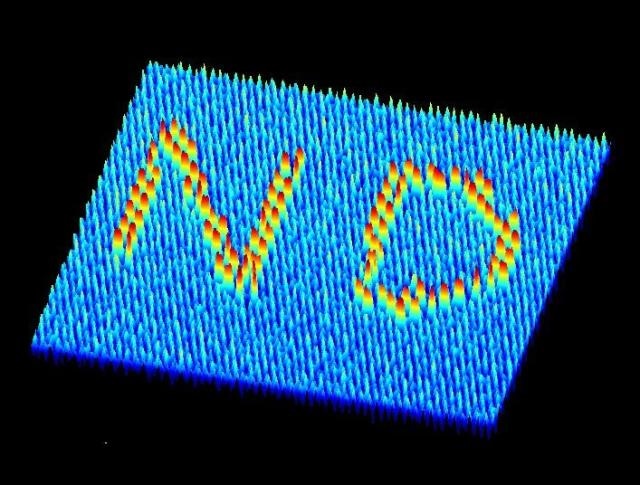May 23 2016
The first rewriteable synthetic magnetic charge ice has been developed by physicists from the University of Notre Dame and their collaborators. The study, explained today in a paper published in Science, suggests huge potential for technological applications right from reprogrammable magnonics and information encoding to spintronics.
 These are magnetic force microscopy images of the patterned magnetic charge ice with 'ND' letters (initials of Notre Dame). (Credit- Yong-Lei Wang/Zhili Xiao)
These are magnetic force microscopy images of the patterned magnetic charge ice with 'ND' letters (initials of Notre Dame). (Credit- Yong-Lei Wang/Zhili Xiao)
Yong-Lei Wang, Notre Dame physicist, and his co-workers have discovered an innovative method of designing synthetic spin ices with magnetic ordered states that are controllable. This new magnetic metamaterial forms eight kinds of 'magnetic charge' ordering, which obeys the "two-positive two-negative" charge ice rule and enables the first rewritable artificial magnetic charge ice (MCI). This work shows methods to change the charge ordering both at the local level and global level. The 'read-write-erase' multiple recording functions are realized suitably at room temperature.
Artificial spin ice is a kind of lithographically produced arrays of magnetic nano-islands interacting with each other. As a result of its geometrical anisotropy, the lengthened nano-scale island creates a sole magnetic domain, which acts like 'macro spin' with two degrees of freedom. The 'spins' in artificial spin ice follow the 'two-in two-out' ice rule that establishes the proton positional ordering in water ice.
Researchers have developed artificial spin ice systems as models to examine complex magnetism in crystals and the associated physics in a material that can be suited with specific properties and be examined through direct imaging. Owing to the excess of spin configurations, artificial spin ices have huge potential for memory, data storage, and logic devices applications. Yet, because of the huge magnetic energy scales of these nanoscale islands at room temperature, reaching the magnetic ground and higher ordered states in conventional artificial spin ices have represented a huge difficulty for almost a decade ever since the first artificial spin ice was formed. This basically reduces the practical application of synthetic ices.
We solved the challenge with a new way of thinking. Instead of focusing on spins, we tackled the associated magnetic charges that allow us to design and create artificial magnetic charge ices with more control.
Yong-Lei Wang, Physicist, University of Notre Dame
The stray magnetic field distribution of every lengthened magnetic island can be shown as a dumbbell of magnetic charges, a positive and a negative. Wang and his co-workers showed an easy method to redesign the spin texture of artificial spin ice whilst maintaining its magnetic charge map. The decoupling of magnetic spins and magnetic charges allows them to develop preferred and new magnetic charge ordered states by changing the magnetic textures via an applied external magnetic field.
"Our realization of tunable artificial magnetic charge ices is similar to the creation of a 'smart' material. It provides a versatile platform to advance our knowledge about artificial spin ices, to discover new physical phenomena and to achieve desired functionalities for applications," said Zhili Xiao, the co-corresponding author of the project and holds a mutual appointment between Northern Illinois University and Argonne National Laboratory.
The scientists also demonstrate how to use a MFM magnetic tip as a confined perturbation of the field applied to flip 'single spin' and to influence local charge ordering. They showed the 'read-write-erase' recording functionality of the magnetic charge ice at room temperature. They also developed µm scale magnetic charge letters 'ND' (initial letters of Notre Dame), which is an excited magnetic state enclosed by a ground state environment. This could result in a new magnetic micro patterning practice by shifting these magnetic patterns to further materials using magnetolithography.
By combining these magnetic nano-patterned structures with other materials such as superconductors, our rewritable magnetic charge ice provides an ideal and versatile playground to explore and control new emergent properties that can arise from novel hybrid structures.
Wai-Kwong Kwok, Superconducting and Magnetism Group, Argonne